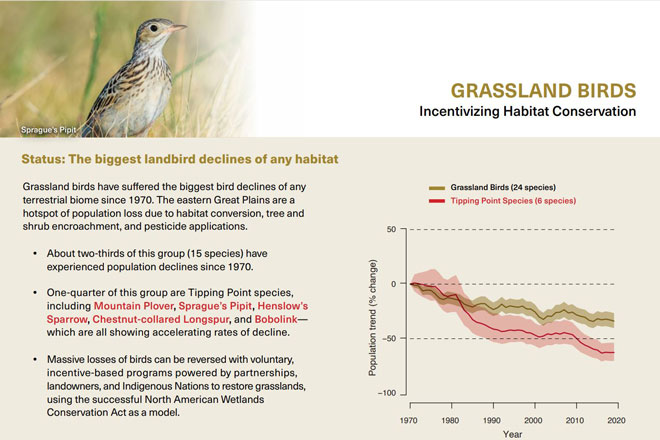A Heartbreaker that can be Reversed
In mid-October, the 2022 U.S. State of the Birds Report was released by the North American Bird Conservation Initiative (NABCI). The news was mostly not good.
The report concludes that “Grassland birds have suffered the biggest bird declines of any terrestrial biome since 1970... due to habitat conversion, tree and shrub encroachment, and pesticide applications.” About two-thirds of grassland bird species have experienced population declines, and one-fourth are considered “tipping point species,” which are those having lost at least half of their breeding population since 1970.

Of course, these threats to habitat are not just abstractly producing downward trendlines of grassland birds and biodiversity, they’re putting populations of pheasants, quail, and other wildlife at serious risk. Indeed, while grassland bird populations overall have declined by more than half since 1970, America’s upland hunters have also witnessed the decline of pheasant and quail in some of their favorite covers.
Here's the one bright spot: despite the negative impacts of recent extreme drought on waterfowl and wetland birds, the population trends of these species still show dramatic long-term recoveries. NABCI attributes this to successful policies and programs like the North American Wetlands Conservation Act (NAWCA) and the Wetlands Reserve Program/Wetland Reserve Easements under the U.S. Farm Bill. It’s suggested that NAWCA can serve as a model to reverse declines of grassland birds through “voluntary, incentive-based programs powered by partnerships, landowners, and Indigenous Nations to restore grasslands.
The wheels are in motion to create similar programs for grassland birds, including the North American Grasslands Conservation Act that was introduced in late July, the upcoming efforts for the 2023 Farm Bill, and sustainability initiatives positively influencing large swaths of the country. If we’re to recover grassland bird populations in the United States – and the report certainly provides hope that we can – Pheasants Forever and Quail Forever will need to continue being a leading voice for grasslands along with our members and partners in the following categories:
North American Grasslands Conservation Act: Introduced in the United States Senate on July 27 by Senator Ron Wyden of Oregon and co-sponsored by Senator Amy Klobuchar of Minnesota and Senator Michael Bennet of Colorado, this critical piece of legislation is modeled after NAWCA and provides the necessary tools to boost America’s capacity to conserve grasslands and the pheasants, quail, prairie grouse, honeybees, Monarch butterflies, and myriad of wildlife species dependent upon them. More than 50,000 voices helped us achieve Act language and bill introduction – but our collective voice for the uplands is now required to carry this monumental legislation to the finish line.
Visit ActforGrasslands.org right now and take action by submitting a form that will deliver a message of support for America's cherished grasslands and sagebrush to your United States Senator.
2023 Farm Bill: The Conservation Title of the Farm Bill is widely recognized as the primary driver of grassland bird populations in North America, especially pheasant and quail populations. Reauthorization of the Farm Bill in 2023 is a huge opportunity to provide more incentives for voluntary conservation of grasslands in America – our robust government relations team members and the voice of upland hunters will be crucial in this upcoming fight. Stay tuned for more information and action alerts as this priority legislation moves forward in Congress.
Sustainability: This new opportunity exists to ensure wildlife conservation efforts can help meet the growing interests and demands for farm sustainability and regenerative agriculture. Worldwide corporate spending on services to increase and track sustainability efforts is expected to grow to $158 billion by 2025. Many of these efforts seek to boost carbon storage and soil health, protect water quantity, and benefit water and air quality. Targeting the right acres to enroll in conservation programs can turn creation of wildlife habitat into a means of providing these highly valued sustainability outcomes and can even maximize net farm profits while sustaining grassland birds. Learn more about PF & QF’s Precision Ag and Conservation Program, including the many new partnerships we’ve developed in the agricultural sector.
Make no mistake about it, the 2022 State of the Bird Report delivers bad news. Very bad news. Our beloved upland game birds are in peril because our grasslands are disappearing before our eyes. Now more than ever, it’s time for our elected officials to hear from all of us and take these steps to provide the tools necessary to reverse the decline of grassland habitat loss. Please add your voice to call for action, and help us answer the Call of the Uplands as we look to successfully conclude our first-ever comprehensive national campaign to cultivate the next generation of conservationists, enhance over 9 million acres of upland habitat, and permanently protect 75,000 acres of land FOREVER.